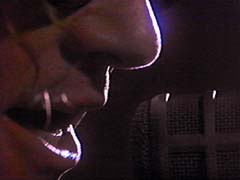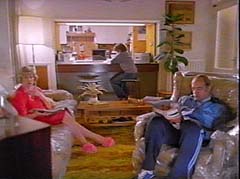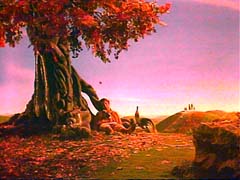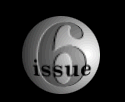|

An extreme close-up of the deejay’s mouth as he
spews vitriol into the microphone in The Fisher King.
Gilliam is not interested in capturing "reality" so much as capturing a particular mood or feeling. He produces this specific feeling in one of two ways. The first type tends to be bleak in tone. In these cases, Gilliam shows the negative effect of modernity unleashed upon the world. One example comes from the opening sequence of Time Bandits (1981). Here, Gilliam uses several levels of meaning to prove his point: match cutting from square houses in an aerial shot to a close-up of square appliances displayed on a square TV, the framing of the characters as they lounge on plastic-covered living room furniture, and even the voice-over coming from the television, which boasts "The Moderna Wonder-major all-automatic convenient centerette gives you all the time in the world to do the things you really want to do!"

In Time Bandits, Kevin's parents sit on plastic-covered
living room furniture while watching television.
Contrasted against these shots of life dominated by modernity are ones that emphasize a world of fantasy. Interestingly, there are far fewer of these shots in Gilliam’s work than the former type, making their significance all the much greater. The first "flashback" sequence in The Adventures of Baron Munchausen (1989), in which the Baron details how he started the war with the Sultan, includes a shot that shows Bertold (Eric Idle) napping underneath a tree. The background for this shot appears absolutely fake, as if it were a series of two-dimensional backdrops painted in Technicolor. Like the opening of Time Bandits, this shot also transports the viewer into a realm of artificiality and surrealism, although in an evidently different manner. This shot is much more pastoral, while the previous one is melancholic.

Bertold (Eric Idle) naps beneath a tree in
The Adventures of Baron Munchausen.
Interestingly, the above two examples echo the way Chateaubriand employed the term modernity in an 1833 journal entry written during his trip from Paris to Prague. He used "’modernite’ to refer disparagingly to the meanness and banality of everyday ‘modern life’ [as seen in Time Bandits], as opposed to the eternal sublimity of nature and the grandeur of a legendary medieval past [as seen in Munchausen]."1 Furthermore, these examples refer to the two modes of aesthetic modernism put forth by Jean-François Lyotard in his essay, "Answering the Question: What is Postmodernism?" which are, in the simplest terms, optimism and pessimism. Even though both modes are reactive responses to social modernity, one movie is interspersed with images of a better world (optimistic fantasy: Munchausen), while the other deconstructs the present civilization strictly for critiquing its faults (pessimistic modernity: Time Bandits).2 As will be demonstrated through further examples in a reading of his most widely known film, Brazil, Gilliam’s films constantly move between these two poles, parodying the ills of social modernity on one hand and offering the hope of something more meaningful in life on the other.
page 1 of 4
 
© Keith James Hamel
photo credits: MCA Universal Home Video, Columbia TriStar Home Video, Paramount Home Video
|



